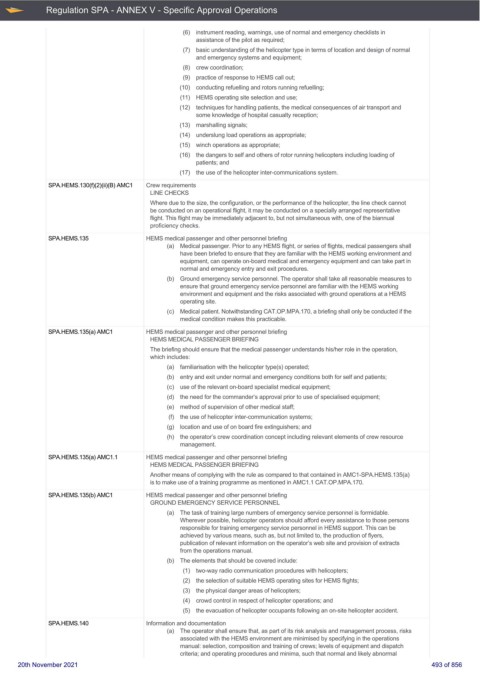Page 493 - UK Air Operations Regulations 201121
P. 493
~
~ Regulation SPA - ANNEX V - Specific Approval Operations Centrik
(6) instrument reading, warnings, use of normal and emergency checklists in
assistance of the pilot as required;
(7) basic understanding of the helicopter type in terms of location and design of normal
and emergency systems and equipment;
(8) crew coordination;
(9) practice of response to HEMS call out;
(10) conducting refuelling and rotors running refuelling;
(11) HEMS operating site selection and use;
(12) techniques for handling patients, the medical consequences of air transport and
some knowledge of hospital casualty reception;
(13) marshalling signals;
(14) underslung load operations as appropriate;
(15) winch operations as appropriate;
(16) the dangers to self and others of rotor running helicopters including loading of
patients; and
(17) the use of the helicopter inter-communications system.
SPA.HEMS.130(f)(2)(ii)(B) AMC1 Crew requirements
LINE CHECKS
Where due to the size, the configuration, or the performance of the helicopter, the line check cannot
be conducted on an operational flight, it may be conducted on a specially arranged representative
flight. This flight may be immediately adjacent to, but not simultaneous with, one of the biannual
proficiency checks.
SPA.HEMS.135 HEMS medical passenger and other personnel briefing
(a) Medical passenger. Prior to any HEMS flight, or series of flights, medical passengers shall
have been briefed to ensure that they are familiar with the HEMS working environment and
equipment, can operate on-board medical and emergency equipment and can take part in
normal and emergency entry and exit procedures.
(b) Ground emergency service personnel. The operator shall take all reasonable measures to
ensure that ground emergency service personnel are familiar with the HEMS working
environment and equipment and the risks associated with ground operations at a HEMS
operating site.
(c) Medical patient. Notwithstanding CAT.OP.MPA.170, a briefing shall only be conducted if the
medical condition makes this practicable.
SPA.HEMS.135(a) AMC1 HEMS medical passenger and other personnel briefing
HEMS MEDICAL PASSENGER BRIEFING
The briefing should ensure that the medical passenger understands his/her role in the operation,
which includes:
(a) familiarisation with the helicopter type(s) operated;
(b) entry and exit under normal and emergency conditions both for self and patients;
(c) use of the relevant on-board specialist medical equipment;
(d) the need for the commander’s approval prior to use of specialised equipment;
(e) method of supervision of other medical staff;
(f) the use of helicopter inter-communication systems;
(g) location and use of on board fire extinguishers; and
(h) the operator’s crew coordination concept including relevant elements of crew resource
management.
SPA.HEMS.135(a) AMC1.1 HEMS medical passenger and other personnel briefing
HEMS MEDICAL PASSENGER BRIEFING
Another means of complying with the rule as compared to that contained in AMC1-SPA.HEMS.135(a)
is to make use of a training programme as mentioned in AMC1.1 CAT.OP.MPA.170.
SPA.HEMS.135(b) AMC1 HEMS medical passenger and other personnel briefing
GROUND EMERGENCY SERVICE PERSONNEL
(a) The task of training large numbers of emergency service personnel is formidable.
Wherever possible, helicopter operators should afford every assistance to those persons
responsible for training emergency service personnel in HEMS support. This can be
achieved by various means, such as, but not limited to, the production of flyers,
publication of relevant information on the operator’s web site and provision of extracts
from the operations manual.
(b) The elements that should be covered include:
(1) two-way radio communication procedures with helicopters;
(2) the selection of suitable HEMS operating sites for HEMS flights;
(3) the physical danger areas of helicopters;
(4) crowd control in respect of helicopter operations; and
(5) the evacuation of helicopter occupants following an on-site helicopter accident.
SPA.HEMS.140 Information and documentation
(a) The operator shall ensure that, as part of its risk analysis and management process, risks
associated with the HEMS environment are minimised by specifying in the operations
manual: selection, composition and training of crews; levels of equipment and dispatch
criteria; and operating procedures and minima, such that normal and likely abnormal
20th November 2021 493 of 856

